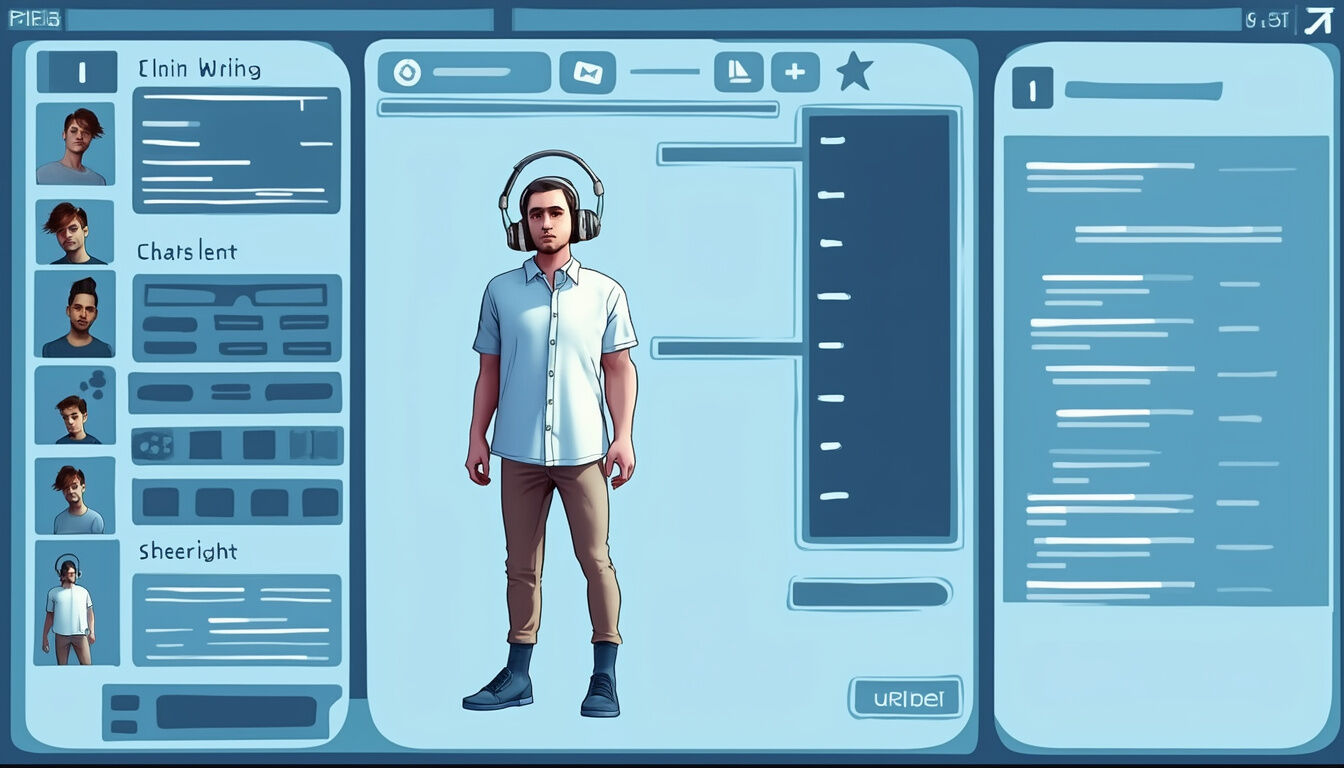As an advanced platform that combines creative tooling and rapid iteration, Beta Character AI enables professionals and hobbyists to design, test and deploy conversational personas across devices. The product sits at the intersection of content creation, conversational design and practical automation: builders can define names, taglines and backstories while also tuning response style and safety settings. This environment is notable for integrating robust features such as voice input, memory toggles and content moderation into a single workflow. Analysts and developers compare the approach to broader Character AI trends in the market and note the platform’s ability to scale from casual chat companions to specialized assistants used in education and customer service.
En bref — Key takeaways
Beta Character AI: rapid persona creation, voice, memory and moderation features.
Platform class: Character AI focused on personality-first interactions and developer tools.
Signup options: email, Google sign-in or Apple; clear privacy controls and sharing tools.
Use cases: education support, gaming NPCs, customer service bots, and creative writing partners.
Subscription: free tier with essential features, premium plan for priority access and advanced tools.
Learn more about adjacent agentic developments and industry perspectives at resources like evolution of agentic AI and case studies on virtual assistants.
Area | What Beta Character AI offers | Related Character AI concept |
|---|---|---|
Creation | Persona editor, appearance, name, tagline and dialogue tuning | Template-driven Character AI model |
Interaction | Text and voice chat, memory recall, emotion-aware responses | Multimodal Character AI |
Safety | Content filters, moderation tools, user controls and reporting | Responsible Character AI deployment |
Business | APIs, sharing, analytics and subscription management | Enterprise-grade Character AI features |
What Is Beta Character AI? Unlocking the Power of Advanced AI Chatbots
Beta Character AI is a platform designed to let users build and interact with digital personas that behave like conversational agents. It sits within the broader field of Character AI, but its emphasis is on hands-on persona design paired with practical deployment options. The service exposes a set of core features that accelerate testing and refinement, and it relies on iterative user feedback to improve responses over time.
Persona templates and free-form editors that let you customize tone and limits.
Moderation and sharing options for safe distribution.
Analytics to understand conversation patterns and performance.
Key insight: Combining creative controls and rigorous test loops makes Beta Character AI a pragmatic entry point for those experimenting with modern Character AI.
How Beta Character AI Uses neural language models for Lifelike Dialogue
The platform applies contemporary neural language models to produce context-aware replies that read as natural. Behind the scenes, model outputs are filtered and guided by persona rules defined by designers; this pipeline balances spontaneity and guardrails. Developers can add situational constraints to shape the tone and factual accuracy of replies, addressing one of the common pitfalls of generative Character AI.”
Context windows and memory scopes to retain conversation threads.
Rule layers that prevent unsafe or off-brand responses.
Key insight: Controlled model steering is central to keeping persona outputs consistent while leveraging large-scale language capabilities.
Personalization Features: Customizing Personalities and Conversations
Beta Character AI includes explicit tools for customize personalities: name, tagline, behavioral rules and example dialogues. These options enable deep personalization, allowing characters to adapt vocabulary, formality and knowledge retention according to user needs. Creators often iterate with A/B tests to refine tone and measure how different features affect engagement.
Tune memory horizons to make characters remember or forget details.
Set emotional style and response pacing to match an intended persona.
Key insight: Fine-grained controls turn abstract model behavior into reliable personalities suitable for production uses.
Getting Started: Step-by-Step Guide to Using Beta Character AI
How to Access Beta Character AI’s Official Website and Sign Up
Visit the official site, select the signup flow and choose from email, Google or Apple authentication. Account creation typically guides you through choosing a username and setting privacy preferences. Many users link a verified email and enable two-factor authentication for account security.
Choose signup method: email, Google or Apple.
Confirm email and set profile details.
Key insight: Simple onboarding reduces friction and helps creators start building characters quickly.
Logging In and Selecting or Creating Your Digital Character
After login, the dashboard shows popular templates and a create-new flow. You can pick an existing public persona or start from blank, setting appearance, name and an initial description. The editor surfaces example prompts and recommended features for different use cases.
Select a template or click “Create new” to begin persona design.
Adjust dialogue samples to teach the character preferred responses.
Key insight: Iterative editing and trial conversations are essential to shaping reliable character behavior.
Initiating Chats: Exploring the Immersive Chat Window
The chat window supports text, voice input and quick-reply options. Users send prompts, follow up for clarifications, and use memory toggles to enable or disable long-term recall. Group chat modes allow multiple characters to interact for creative storytelling or roleplay.
Use voice input or typed messages; read responses and test edge cases.
Enable or mute memory to control recall across sessions.
Key insight: Live testing in the chat window gives immediate feedback for persona refinement.

Key Features of Beta Character AI That Enhance User Experience
AI Character Creation: Defining Unique Traits, Appearance, and Dialogue
Character builders can define a character’s voice, backstory and constraints. The editor provides sliders and text fields to tune verbosity and empathy, enabling creators to shape responses for specific audiences. Export and sharing options let teams collaborate and iterate on persona design.
Templates for rapid prototyping and advanced fields for professional customizations.
Built-in testing harness to simulate different user intents.
Key insight: Ease of creation accelerates experimentation and broad adoption across teams.
Multi-Character and Group Chat Capabilities
Group chat supports multiple active personas interacting in a shared thread, useful for narrative design and multi-agent simulations. These sessions can be recorded and analyzed for conversational patterns, whether for training or entertainment. Designers often stage roleplay scenarios to stress-test consistency.
Run moderated multi-agent scenes for storytelling and training.
Export transcripts for review and model tuning.
Key insight: Multi-character sessions reveal emergent behavior and enable complex use cases.
Voice Interaction, Memory Recall, and Emotional Intelligence
Voice input and synthesized replies make interactions more natural, and memory recall helps continuity across sessions. The platform offers sentiment-aware responses—adjusting empathy and tone—relying on sentiment analysis modules that approximate emotional intelligence. These capabilities are particularly valuable in education and therapeutic-simulated scenarios (non-clinical).
Voice-to-text and TTS for hands-free conversations.
Memory toggles to balance personalization with privacy.
Key insight: Human-like interaction requires combining voice, memory and affect-aware responses with clear guardrails.
Privacy, Data Security, and Content Moderation Measures
Ensuring Safe Conversations with Moderation Filters
Beta Character AI applies content moderation filters to block abusive, hateful or sexually explicit outputs. Creators can fine-tune sensitivity and content policies to match target audiences. The moderation layer helps platforms remain compliant and safe for public sharing.
Automated filters and human review pipelines.
Report tools for community oversight and safety tuning.
Key insight: Proactive moderation reduces risk and encourages broader use in regulated contexts.
User Profiles, Data Handling Policies, and Sharing Tools
Detailed privacy settings let users control what data is retained; encrypted storage and transparent deletion options are provided. APIs for analytics and export are secured by authentication, and sharing tools let creators publish characters with configurable permissions. For enterprise customers, integrations with analytics stacks and compliance audits are available.
Data retention controls and account-level privacy toggles.
Export, revoke and delete options for compliance.
Key insight: Transparent controls and secure defaults help build trust among creators and organizations.
Real-World Applications of Beta Character AI Across Industries
Education, Training, and Programming Assistance
Teachers use persona-based tutors to deliver interactive lessons and quiz students. Developers rely on characters for pair-programming exercises, debugging help and sample explanations. Training scenarios let organizations simulate customer interactions for staff practice.
Adaptive tutors that recall student progress and provide tailored drills.
Programming walkthroughs and code explanation assistants.
Key insight: Persona-driven tutoring improves engagement by matching tone and pacing to learners’ needs.
Entertainment, Gaming, and Casual Interactions
Game studios prototype NPC personalities quickly with the persona editor, and writers use characters as brainstorming partners. Casual users appreciate conversational companions for storytelling and roleplay. Integration with virtual worlds is an active development area, referenced in industry reviews and app guides such as the Big App Guide 2025.
NPC prototyping for dialogue-rich games.
Collaborative writing with character prompts and scene generation.
Key insight: Fast persona iteration shortens development cycles for narrative-driven experiences.
Customer Service, Marketing, and Data Analysis Uses
Brands deploy persona-based assistants for triage and FAQ handling, combining automation with escalation to human agents. Marketers use characters for interactive campaigns and data collection with consent. Analytics on conversation flows power product improvements and UX research; see industry insights on AI-driven search and customer engagement.
Conversation routing for tiered support handling.
Interactive marketing bots that collect qualified leads.
Key insight: Character-first automation can improve user satisfaction while reducing repetitive support costs.
Challenges and Limitations: What Users Should Know About Beta Character AI
Pattern-Based AI Responses and Occasional Misunderstandings
Like other Character AI systems, outputs are pattern-based; they do not reflect true understanding. Complex or ambiguous inputs can produce inconsistent answers, so designers must craft robust constraints and examples. Good prompt engineering and context provisioning reduce misunderstandings.
Ambiguous input leads to generic or incorrect replies.
Breaks in character can occur without strong behavioral rules.
Key insight: Expect and design for error modes by rehearsing edge-case conversations.
Biases, Privacy Concerns, and Emotional Implications
Training data can introduce bias; moderation and explicit persona rules mitigate this risk. Users should avoid treating characters as substitutes for humans, since emotional mimicry does not equal genuine empathy. Privacy-friendly defaults and clear retention policies help reduce data exposure.
Bias mitigation and transparency remain priorities.
Users may form attachments; clear disclaimers reduce risk.
Key insight: Ethical deployment requires both technical safeguards and user education.
Technical Issues: Server Slowdowns and Ongoing Improvements
Popular Character AI platforms can experience occasional latency or rate limits during peak demand. Infrastructure upgrades and premium plans address priority access. Developers should design failover strategies and graceful degradation for production use.
Expect occasional slowdowns; plan for retries and caching.
Premium infrastructure tiers reduce wait times.
Key insight: Resilience planning is part of adopting any cloud-based conversational platform.
Issue | Likely cause | Remedy |
|---|---|---|
Incoherent replies | Insufficient context or ambiguous prompt | Provide clearer prompts, add conversation examples |
Slow responses | Server load or network issues | Retry later, upgrade plan if needed |
Privacy concern | Enabled memory or sharing | Disable memory, adjust sharing settings |
Beta Character AI Popularity, Growth, and Competitive Standing
User Statistics, Funding Milestones, and Market Position
Beta Character AI has grown rapidly as creators and enterprises adopt persona-first bots. Reports cite rising app downloads and investor interest in agentic solutions; complementary analysis can be found in coverage about AI agents market growth and agentic AI takeaways. The platform competes with other Character AI tools by focusing on persona controls and rapid iteration.
High adoption among creative communities and educational pilots.
Ongoing infrastructure investments to support scale.
Key insight: A character-centric approach differentiates the product in a crowded conversational market.
Troubleshooting Common Issues in Beta Character AI
Solving Misunderstandings, Incoherent Responses, and Input Errors
When conversations derail, rephrase inputs, provide explicit context and use example turns to shape replies. Adjust persona limits to restrict hallucinations and use memory toggles to test differences between stateless and stateful modes.
Rephrase and add examples for clarity.
Use trial conversations in the editor to diagnose behavior.
Key insight: Iterative testing is the most practical path to stable character behavior.
Addressing Privacy Concerns and Character Inconsistencies
Use privacy settings to control retention and sharing, and lock sensitive fields. For inconsistent personalities, tighten rules and provide more sample dialogues. Engage moderation tools when necessary and audit conversation logs for policy compliance.
Audit logs for unexpected behavior.
Tighten persona rules to enforce consistency.
Key insight: Configuration and policy work hand-in-hand to maintain trust and reliability.
Comparing Beta Character AI: Unique Strengths Against Leading AI Tools
Differences in Customization, Voice Interaction, and Memory Capabilities
Compared with general-purpose assistants like ChatGPT, Beta Character AI emphasizes persona controls, multi-character sessions and a richer creator workflow. These differences make it better suited to character-driven applications, while general models remain stronger for open-ended knowledge tasks.
Persona-first tooling vs. generalist conversational models.
Memory and voice features tailored for characters rather than pure retrieval.
Key insight: Choose toolsets based on whether you need character fidelity or broad knowledge recall.
App Accessibility, Experimental Features, and Privacy Standards
Mobile apps provide offline caches and voice input; experimental flags unlock beta features. Privacy and security remain core selling points, with encrypted storage and clear deletion paths. For deeper technical comparisons see reviews and technical retrospectives on NLP advancements and agentic AI research.
Mobile-first conveniences and experimental toggles.
Transparent privacy docs and enterprise options.
Key insight: Accessibility and clear policies determine adoption in regulated environments.
Advanced Guide: App Download, Account Management, and Expert Usage Tips
How to Download and Set Up Beta Character AI on Android and iOS Devices
Find the official app in stores, install and sign in with email or social login. Grant microphone permission for voice features and test the default character to verify audio and networking. Mobile apps often include patches for offline caching and voice input improvements.
Install from official stores and enable permissions.
Test voice and network behavior immediately after setup.
Key insight: Mobile setup is straightforward but verify audio and privacy settings before productive use.
Account Creation, Login Steps, and Password Recovery
Sign up, verify email, set display name and password. For recovery enable a backup email or phone. The dashboard exposes persona templates and analytics after login.
Use strong passwords and enable two-factor authentication for security.
Keep recovery options up to date.
Key insight: Secure account hygiene protects creators and their audiences.
How to Delete Your Beta Character AI Account: Steps and Cautions
Account deletion is done via settings with confirmation steps; deletion is irreversible and removes associated characters and data. Export any needed transcripts before proceeding. Contact support for enterprise data requests.
Export data, then confirm deletion in account settings.
Understand the permanence and backup needs before deleting.
Key insight: Deletion is permanent—plan exports and backups first.
How do I improve inconsistent character replies?
Provide clearer prompts, add sample dialogues in the persona editor and restrict memory scope. Iteratively test edge cases to refine behavior.
Can I use Beta Character AI for commercial projects?
Yes. Review the terms, choose an appropriate subscription tier for scale, and enable enterprise features for compliance and analytics.
What privacy controls exist for stored conversations?
Users can disable memory, delete conversation history, and set sharing permissions. Enterprise customers get enhanced data governance options.
How does Beta Character AI differ from general chat platforms?
It focuses on persona-first tools, multi-character interactions and creator workflows, whereas general chat platforms prioritize broad knowledge access.


